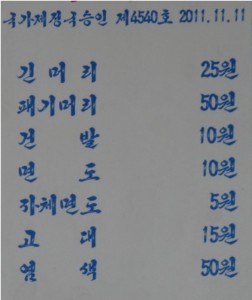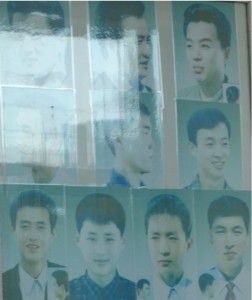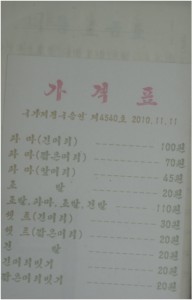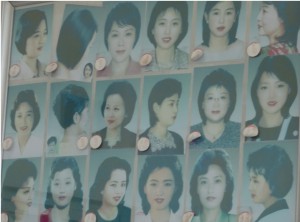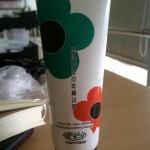Daily NK
Park In Ho
1/1/2009
The marketplace has become an extremely important ground in North Korean people’s lives. 70 percent of North Korean households in the city live off trade, handicrafts and transportation businesses related to trade. If the jangmadang works well, people’s living situation is good, otherwise it is not. In the situation where the food distribution system has broken down, the whole economic existence of the populace is bound up in jangmadang trade.
Trade is bound to generate successful merchants but also failures, due to a lack of know-how or confiscation of products by the People’s Safety Agency (PSA), or simply because a competition system operates. These failures in the jangmadang do not have any second opportunity to rise again so they frequently choose extreme acts like defection, criminality or suicide. Failure is serious.
However, the revitalization of markets has caused great changes in North Korean people’s values. The individual-centered mentality among the people is expanding and the belief that money is the best tool is also spreading. Due to such effects, the North Korean communist authorities in 2008 made the regulation to prohibit women younger than 40 years old from doing business, but of course the people use all necessary means to maintain their survival.
Daily NK investigated the 2008 top ten items in the jangmadang, so as to observe developments in North Korean society.
1. Rice in artificial meat, the first instance of domestic handicraft
Since 2000, the most ubiquitous street food has been “rice in artificial meat,” which is made from fried tofu with seasoned rice filling. This food is found everywhere on North Korean streets. One can find women who sell this snack in alleys, at bus stops and around stations. It costs 100 to 150 North Korean Won.
Meanwhile, the most popular street food is fried long-twisted bread. Individuals make the fried bread at home and sell it on the street. The length of the fried bread is around 20 centimeters and it sells for 100 won.
In around 2005 corn noodles were popular on the streets, but now street-stands for noodles have largely disappeared due to the existence of a permanent store controlled by the state.
These days, if one can afford to eat corn noodles, at approximately 1,000 won for a meal, one can safely say that one is living comfortably.
2. Car battery lights North Korea
The reason why North Korean people like car batteries is that the authorities provide a reliable electricity supply during the daytime, when consumption is less than at night, but at night they don not offer it. The authorities shut down the circuit from around 8 PM to 9PM, and from 12 AM to 2 AM: when the people watch television the most.
As a result, the people charge their car batteries during daytime and use it at night. A 12V battery can run a television and 30-watt light bulb. If they utilize a converter, they can use a color television, which needs more electricity.
Ownership of batteries is a standard of wealth. Officials use electricity from batteries in each room. They usually draw thick curtains in their rooms, to prevent light shining through that might draw attention to their status.
3. The strong wind of South Korean brand’ rice-cooker, Cuckoo
A South Korean brand pressure rice-cooker called Cuckoo appeared as a new icon for evaluating financial power among North Korean elites.
It has spread from the three Chinese northeast provinces into North Korea. In North Korea, Chinese rice and third country aid rice, dry compared to Korean sticky rice, generally circulates, but if the lucky few use this rice-cooker, they can taste sticky rice the way Korean people like it.
There are Cuckoo rice-cookers from South Korean factories that arrive through Korean-Chinese merchants, and surely other Cuckoo products from Chinese factories. These two kinds of rice-cookers, despite having the same brand name, sell for different prices.
The Chinese-made Cuckoo sells for 400,000-700,000 North Korean Won (approximately USD114-200), while the South Korean variety costs 800,000-1,200,000 (approximately USD229-343). A Cuckoo rice-cooker tallies with the price of a house in rural areas of North Korea. According to inside sources, they are selling like wildfire.
4. An electric shaver only for trips
The electric shaver is another symbol of wealth.
It is not that they use electric shavers normally, because one cannot provide durability. At home, North Korean men generally use disposable shavers with two blades made in China or a conventional razor. However, when they take a business trip or have to take part in remote activities, they bring the electric shaver.
There are North Korean-made shavers but most are imported from China. Among Chinese products, you can see “Motorola” products and fake-South Korean products with fake labels in Korean. A Chinese-made electric shaver is around 20,000-40,000 North Korean Won.
5. Chosun men’s fancy shoes
Dress shoes are one of the most important items for Chosun men when they have to participate in diverse political events, loyalty vows or greeting events at Kim Il Sung statues on holidays. Right after the famine in the late 1990s, it was considered a symbol of the wealth, but now general workers, farmers and students are wearing dress shoes.
The shiny enameled leather shoes with a hard heel cannot be produced in North Korea because of a lack of leather. The North Korean authorities provide the National Security Agency (NSA) and officers of the People’s Army with dress shoes, which are durable but too hard and uncomfortable.
Shoes for general citizens and students are mostly made in China and some are produced in joint enterprises in Rajin-Sunbong. The price of shoes ranges from 30,000 to 100,000 Won depending upon the quality.
6. Cosmetics prosper despite the economic crisis
Cosmetics and accessories for women are getting more varied. Lately, false eyelashes have appeared in the jangmadang in major cities. Chinese cosmetics are mainly sold, alongside fake South Korean brands. In Pyongyang, Nampo, Wonsan and Shinuiju Chinese and even European cosmetics are on sale.
“Spring Fragrance,” a North Korean luxury cosmetics brand, is famous for being Kim Jong Il’s gift that he presents to women soldiers or artists when he visits military units or cultural performances. It costs more than 200,000 North Korean won.
Lotions for women, made in China, are approximately 2,000-4,000 won, foundation cream is 3,000-5,000 won, and lipstick is from 500 won to 2,000 won. Hand cream is 3,000-5,000 won.
7. Hana Electronics recorder, the biggest state-monopoly production
“Hana Electronics” was originally set up to produce CDs and DVDs of North Korean gymnastic performances or other artistic performances, so as to export them foreign countries. The company has been producing DVD players since 2005.
Due to the state monopoly, the DVD player of the Hana Electronics dominates the market. North Korean people call a VCR and a DVD player a “recorder.” Since around 2005, after the booming interest in South Korean movies and dramas, the players have been selling very well.
At the beginning, North Korean visitors to China brought the DVD or CD players into North Korea, but as they got popular among the people, Chinese-made players were imported from China and since 2006 they have been really popular in every jangmadang.
Accordingly, since 2006, the authorities have started blocking the importation of the Chinese player and are selling the Hana Electronics players, which sell for around a 20 or 30 percent higher price than Chinese players in state-run stores. Now, they can be sold in the jangmadang by private merchants and comparatively free from inspection by the PSA. The prices are 130,000-150,000 won.
8. Bicycles are basic, the motorcycle era is here now
In major cities, numbers of motorcycles are increasing. Especially in border regions where smuggling with China is easier than in other cities, motorcycles are common.
The motorcycles are ordinarily used for mid or long distance business. Most motorcycles are made in China and some are Japanese second-handed products, which sell for 1.5-2.5 million won. 125cc new products are over 5 million won. The cheapest second-handed motorcycle is 500,000 won.
9. Vinyl floor covering for the middle class and vinyl for the poor
Demand for vinyl floor coverings and vinyl has been increasing since the late 1990s, when residential conditions improved. In the late-1990s people had to use sacks of cement or Rodong Shinmun (newspaper) as a floor covering, but now they are using vinyl floor coverings.
Uses for vinyl are unimaginably diverse: from a basic protection against wind and cold to when people take a shower at home in the vinyl tunnel hung on the ceiling of the bathroom.
Depending on the thickness and width, there are four or five kinds of vinyl in the jangmadang for from 150 to 500 won. Vinyl floor covering is a Chinese product selling for from 3,000 to 10,000 won.

